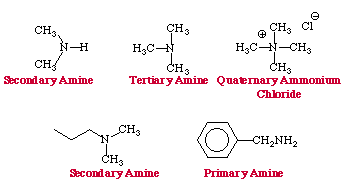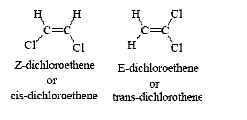
Stereoisomers (briefly and non-optical only!)
Geometric isomers are stereoisomers that are distinct and separate because they cannot freely rotate due to a multiple bond or a ring structure. Geometric isomers are generally not optical isomers unless they also happen to have chiral centers. These isomers are superimposable on their mirror images if no chiral centers are present. The isomers are diasteromers according to the definition given here.

There are two naming conventions. The older method uses cis- and trans- which works well for the example given above because there are two H atoms and two Cl atoms. But it won’t work well if there were four different atoms involved. The newer method ranks the substituents for each C atom according to the Cahn-Ingold-Prelog sequence rules. (Carey, Organic Chemistry pp. 268-272). If the two with the higher rankings are on the same side of the double bond, that isomer is Z (for the German word zusammen, which means together).
The other isomer is E (for entgegen meaning opposite). Briefly, the sequence rules rank the substituents in order of decreasing atomic number and if two or more atoms connected to the C atom are the same the second atom determines the order.
Functional Groups
Organic chemistry is dominated by the "functional group approach", where organic molecules are deemed to be constructed from:
The functional group approach "works" because the properties and reaction chemistry of a particular functional group (FG) can be remarkably independent of environment.
Therefore, it is only necessary to know about the chemistry of a few generic functions in order to predict the chemical behaviour of thousands of real organic chemicals.
Organic molecules are also named using the functional group approach:
2-hexanone
2-hexanol
2-chlorohexane
The rule is that functions assume their distinct identity when separated by –CH2– groups. Thus, the carbonyl, C=O, and hydroxy, OH, of a carboxylic acid, RCOOH, are part of a single function and are NOT "alcohol-plus-ketone":
A Couple of Words About The Functional Group Approach
The functional group approach is 100% empirical in that it is determined by experiment and experience, and not by theory (unlike VSEPR, for example.)
A multifunctional entity like the drug molecule morphine may have several functional groups and chiral centers:
Alkane |
Alkyl, and occasionally aryl (aromatic) functions are represented by the R- Methyl: CH3– Ethyl: CH3CH2– Propyl: CH3CH2CH2– Isopropyl: (CH3)2CH– Phenyl: C6H5– etc. |
Alkyl halide |
Alkyl halides [haloalkanes] consist of an alkyl group attached to a halogen: F, Cl, Br, I. Chloro, bromo and iodo alkyl halides are often susceptible to elimination and/or nucleophilic substitution reactions. |
Primary alcohol |
Primary alcohols have an -OH function attached to an R-CH2- group. Primary alcohols can be oxidised to aldehydes and on to carboxylic acids. (It can be difficult to stop the oxidation at the aldehyde stage.) Primary alcohols can be shown in text as: RCH2OH |
Secondary alcohol |
Secondary alcohols have an -OH function attached to a R2CH- group. Secondary alcohols can be oxidised to ketones. Secondary alcohols can be shown in text as: R2CHOH |
Tertiary alcohol |
Tertiary alcohols have an -OH function attached to a R3C- group. Tertiary alcohols are resistant to oxidation with acidified potassium dichromate(VI), K. Tertiary alcohols can be shown in text as: R3COH |
Aldehyde |
Aldehydes have a hydrogen and an alkyl (or aromatic) group attached to a carbonyl function. Aldehydes can be shown in text as: RCHO Aldehydes are easily oxidised to carboxylic acids, and they can be reduced to primary alcohols. Aldehydes can be distinguished from ketones by giving positive test results with Fehlings solution (brick red precipitate) or Tollens reagent (silver mirror). Aldehydes give red-orange precipitates with 2,4-dinitrophenyl hydrazine. |
Ketone |
Ketones have a pair of alkyl or aromatic groups attached to a carbonyl function. Ketones can be shown in text as: RCOR Ketones can be distinguished from aldehydes by giving negative test results with FehlingÕs solution (brick red precipitate) or Tollens reagent (silver mirror). Ketones give red-orange precipitates with 2,4-dinitrophenyl hydrazine. |
Carboxylic acid |
Carboxylic acids have an alkyl or aromatic groups attached to a hydroxy-carbonyl function. Carboxylic acids can be shown in text as: RCOOH Carboxylic acids are weak Bronsted acids and they liberate CO2 from carbonates and hydrogen carbonates. |
Carbonyl function |
The carbonyl group is a super function because many common functional groups are based on a carbonyl, including: aldehydes, ketones, carboxylic acids, esters, amides, acyl (acid) chlorides, acid anhydrides |
Ester |
Esters have a pair of alkyl or aromatic groups attached to a carbonyl + linking oxygen function. Esters can be shown in text as: RCOOR or (occasionally) ROCOR. carboxylic acid + alcohol -> ester + water This is an acid catalysed equilibrium. |
Amide |
Primary amides (shown) have an alkyl or aromatic group attached to an amino-carbonyl function. Primary amides can be shown in text as: RCONH2 Secondary amides have an alkyl or aryl group attached to the nitrogen: RCONHR Tertiary amides have two alkyl or aryl group attached to the nitrogen: RCONR2 |
Primary amine |
Primary amines have an alkyl or aromatic group and two hydrogens attached to a nitrogen atom. Primary amines can be shown in text as: RNH2 Primary amines are basic functions that can be protonated to the corresponding ammonium ion. Primary amines are also nucleophilic. |
Secondary amine |
Secondary amines have a pair of alkyl or aromatic groups, and a hydrogen, attached to a nitrogen atom. Secondary amines can be shown in text as: R2NH Secondary amines are basic functions that can be protonated to the corresponding ammonium ion. Secondary amines are also nucleophilic. |
Tertiary amine |
Tertiary amines have three alkyl or aromatic groups attached to a nitrogen atom. Tertiary amines can be shown in text as: R3N Tertiary amines are basic functions that can be protonated to the corresponding ammonium ion. Tertiary amines are also nucleophilic. |
Nitrile |
Nitriles (or organo cyanides) have an alkyl (or aromatic) group attached to a carbon-triple-bond-nitrogen function. Nitriles can be shown in text as: RCN Note that there is a nomenclature issue with nitriles/cyanides. If a compound is named as the nitrile then the nitrile carbon is counted and included, but when the compound is named as the cyanide it is not. For example: CH3CH2CN is called propane nitrile or ethyl cyanide (cyanoethane). |
Carboxylate ion or salt |
Carboxylate ions are the conjugate bases of carboxylic acids, ie. the deprotonated carboxylic acid. Carboxylate ions can be shown in text as: RCOO– When the counter ion is included, the salt is being shown. Salts can be shown in text as: RCOONa |
Amino acid |
Amino acids, strictly alpha-amino acids, have carboxylic acid, amino function and a hydrogen attached to a the same carbon atom. There are 20 naturally occurring amino acids. All except glycine (R = H) are chiral and only the L enantiomer is found in nature. Amino acids can be shown in text as: R-CH(NH2)COOH |
Alkene |
Alkenes consist of a C=C double bond function. Alkenes can be shown in text as: Mono substituted: RCH=CH2 1,1-disubstituted: R2C=CH2 1,2-disubstituted: RCH=CHR Alkanes are planar as there is no rotation about the C=C bond. Alkenes are electron rich reactive centres and are susceptible to electrophilic addition. |
trans-Alkene |
trans-alkenes are 1,2-disubstituted functions with the two R, X or other groups on opposite sides of the C=C function. Due to the non-rotation of the C=C bond, cis and trans geometric isomers are not [thermally] Interconverted. |
cis-Alkene |
cis-Alkenes are 1,2-disubstituted functions with the two R, X or other groups on the same side of the C=C function. Due to the non-rotation of the C=C bond, cis and trans geometric isomers are not [thermally] Interconvertion. |
Ether |
Ethers have a pair of alkyl or aromatic groups attached to a linking oxygen atom. Ethers can be shown in text as: ROR Ethers are surprisingly unreactive and are very useful as solvents for many many (but not all) classes of reaction. |
From Mark R. Leach 1999-2008
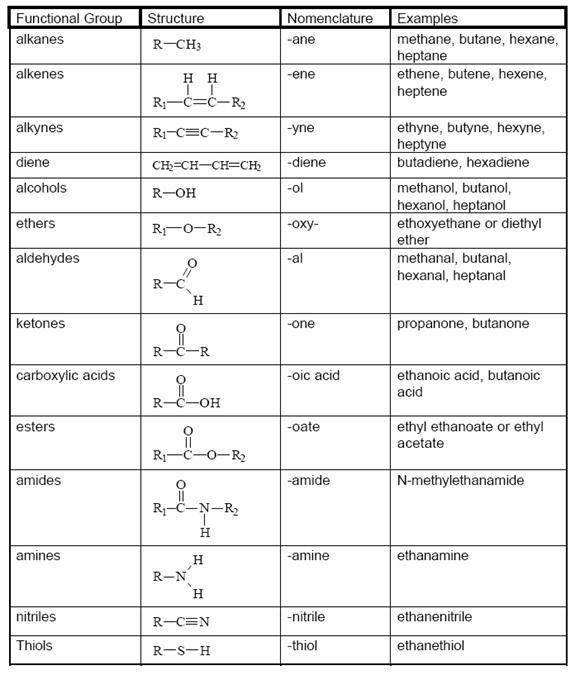
The R represents a carbon based group.
More Nomenclature:
Simple alcohols are named as derivatives of the parent alkane, using the suffix -ol, using the following simple rules:
Simple ethers are named either by identifying the two organic residues and adding the word ether, or, if other functionality is present, the ether residue is named as an alkoxy substituent, as shown below:
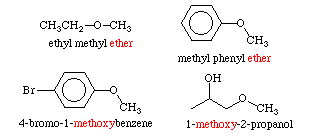
Simple aldehydes and ketones are named using the standard rules of nomenclature which we have used in the past with the following specific changes:
Simple carboxylic acids are named as derivatives of the parent alkane, using the suffix -oic acid
Nomenclature of Aliphatic Amines
Simple amines are named as derivatives of the parent alkane, using the suffix -amine, or by using -amino to name a numbered substituent, using the following rules:Thus for the following example, you would number from the end closest to the nitrogen, generating the names, 3-methylpentanamine (or 1-amino-3-methylpentane) and 5-methyl-2-hexanamine (or 2-amino-5-methyl-2-hexane), respectively.

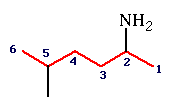
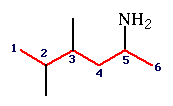
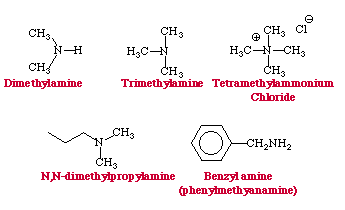
Amines are further categorized as "primary, secondary, tertiary and quarternary" based on the number of substituents on the nitrogen:
